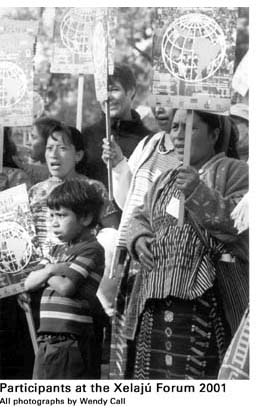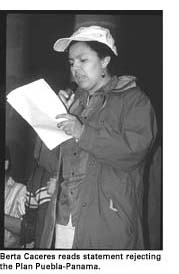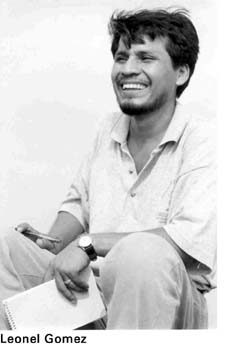Farms vs. Factories
Planning the Future for the
Shortly after sunrise, Leonel Gamez and I stepped into a tiny, wobbling canoe in the Ixtán estuary, next to the Pacific coast town of Champerico, Guatemala. Our host, Enrique Bonilla, squeezed in behind us. As we floated out on the water, much of what Leonel saw was familiar to him, though this was his first visit outside Mexico. Blue-green mangrove leaves shivered in the hot breeze, above thickets of roots that extended from the water. Clouds of birds spiraled overhead. Men, boys, and a couple of women stood waist-deep in the water, tossing out round nets and pulling in shrimp and small fish. Leonel was surprised to find the fishers’ baskets nearly empty after hours of work. Enrique eased the canoe toward the far side of the estuary, so Leonel and I could see the industrial shrimp farm that has nearly destroyed their fishing. After about fifteen minutes of Enrique’s calm paddling, we saw what we had come for: huge, rusted metal pipes belching foamy, brown water in the lagoon. Past the pipes, armed guards stood behind a high fence. Leonel jumped from the canoe into the stinking ooze and slogged up the embankment. He wanted to see the shrimp farm itself, the hundreds of acres of artificial ponds. The fence, men, and rifles prevented him from getting too close.
As we glided away from the installation, Enrique explained how chemical-intensive agriculture and aquaculture have diminished native shrimp and fish populations and the mangroves of the Ixtán estuary. “Here, there aren’t sources of employment. We have to take care of what God gave us.” There is very little left. Guatemala’s Pacific coast has probably lost more than 90 percent of its original mangrove forests. Like Enrique Bonilla, Leonel Gómez is from a fishing village. Leonel’s hometown, San Francisco del Mar, is an indigenous Huave community in Mexico’s Oaxaca state. About one-third of the Huave tribe’s 25,000 members live in San Francisco. It has been primarily a fishing village since it was founded, at least 1,000 years ago. Many Huave also cultivate corn, watermelon, and other crops on the 100,000 acres of land the town owns communally.

The thought of a shrimp farm replacing a chunk of San Francisco del Mar’s lush mangrove swamps has gnawed at Leonel for the past several years. The mangroves serve as nurseries for the fish and shellfish the Huave people harvest from the Pacific lagoons. The trees also maintain water quality and prevent erosion. In just the past decade, shrimp farms have consumed about five percent of all the remaining mangroves in the world.
Leonel and I visited the Ixtán estuary on our way back to Mexico from the “Xelajú Forum 2001,” held in Quetzaltenango, Guatemala, from November 22-24, 2001. Leonel had requested three days away from the fourth-grade class he teaches in San Francisco del Mar so that he could attend the forum. The gathering brought together more than 800 people to discuss Mexican President Vicente Fox’s dream for southern Mexico and Central America: the “Plan Puebla-Panama.” This plan would transform the economy of places like San Francisco del Mar, making many fishers and farmers into workers, most in assembly plant maquiladoras, but some in agricultural plantations, intensive tree plantations, or big shrimp farms.
One afternoon several months before the Xelajú Forum, Leonel had asked me, “So, what is the Plan Puebla-Panama, anyway?” He had said it in an off hand way, as if speaking of something that did not concern him. His question reflected the general level of awareness about the Plan Puebla-Panama (PPP) in the region it encompasses: the southern Mexican states of Campeche, Chiapas, Guerrero, Oaxaca, Puebla, Quintana Roo, Tabasco, Veracruz, and Yucatan, as well as all of Central America: Belize, Guatemala, Honduras, El Salvador, Nicaragua, Costa Rica, and Panama.
The name rankles many, who feel that it belittles Central America, by placing nations on the same level as Mexican states. But the region Fox has carved out does have some common characteristics. Oaxaca state has almost the same illiteracy rate as Honduras-nearly one quarter of the adult population. In El Salvador, the infant mortality rate is 16.5 per thousand live births. In the state of Yucatan, it is 17.1. In Chiapas, phone lines are only slightly more common (30 for every 1,000 residents) than they are in Guatemala (27 per 1,000).
The lead promoters of the PPP-the Mexican government and the Inter-American Development Bank-talk about eight different project areas, including everything from tourism and “sustainable development,” to superhighways and a regional energy grid. When I asked PPP Director Florencio Salazar about the project-as we sat in his penthouse office in Mexico City-he told me the highest priority was highway construction. He spoke of a major highway corridor along the Pacific coast from Mexico through Panama, and another along the Atlantic coast. Since that interview, highways connecting the two corridors have been announced, as well. Several of those proposed highways would cut through some of the region’s most important stands of pristine rainforest in the Mexican states of Oaxaca and Chiapas, as well as in Guatemala and Nicaragua.
The primary document the Mexican government has made public about the PPP (online at www.presiden-cia.gob.mx) does not outline specific proposals, but instead analyzes the region’s economy. The verdict: too economically poor, too rural, not enough highways, too many small farms, not enough telephones, and too many “under-exploited” natural resources. “The region’s fishery, agricultural, and oil resources are of high national importance…,” the report observes. “Some of the resources of the region are not sufficiently exploited.”

It is statements like this-and fear of what they might mean-that inspired representatives from more than 300 associations of peasants, workers, women, local governments, and indigenous communities to gather in Quetzaltenango for the Xelajú Forum. One of the people to take the microphone at the first plenary session was Concepción Colotla. From Puebla, Mexico, Concepción leads the 10,000-member Emiliano Zapata Campesino Association. His Association has been at the center of a violent conflict over farms versus factories. In late 2000, the Puebla state government announced the “Millennium Project,” a plan to transform 50,000 acres of highly productive farmland into two industrial parks for maquiladoras, a golf course, a horse-racing track, and exclusive residential subdivisions. Much of the land in question is currently managed collectively by the people who work it.
In a cowboy hat, with his feet planted wide apart, Concepción’s voice boomed a warning through the cavernous auditorium. “Communities without land cease to be communities.” Sitting in the audience, Leonel nodded his head and murmured his agreement. Concepción had voiced Leonel’s fear precisely. Only the oldest residents of San Francisco del Mar speak Huave and wear traditional clothing. The way Leonel sees it, the things that preserve their indigenous identity-what they eat, how they manage their local government, and how they earn a living-relate to their relationship to the land. Moreover, these things are dependent upon the Huaves’ continued control of it. Concepción concluded his brief speech, “Compañeros, indigenous brothers, I assure you, the only thing the Plan Puebla-Panama is going to bring us is the loss of our land.” The crowd cheered.
Whether or not it is true, this idea is fed in part by the Mexican government’s unwillingness to consult with affected communities about the PPP. Even World Bank representatives in Mexico City have criticized the government’s closed-door approach. In April 2001, public “consultation” meetings were held in several Mexican cities. The three-hour meetings were announced three or four days before they were held, with invitations sent to a handful of non-governmental organizations and academic institutions. The great majority of the people who live in the region never heard about them. (It was a month after these meetings that Leonel asked me what the PPP was.)
The Mexican government has devoted much more attention to gathering a sales team for the four-billion-dollar fundraising effort. The President of the Inter-American Development Bank, Enrique Iglesias, heads the PPP Financing Commission, which also includes several World Bank and United Nations agencies. The commission has made slow but steady progress-in spite of events in the United States. Just one week after the September 11 disaster, Mexico’s Foreign Trade Bank (Bancomext) announced it would invest $300 million in the PPP region: half for hotel development and half for textile and manufacturing industries. In November 2001, Japanese investors agreed to support a huge energy interconnection program in Central America, based on fossil fuels and big dams. On December 15, 2001, the Central American Economic Integra-tion Bank announced it would loan $135 million to El Salvador’s government to rebuild a port and construct several highways.

These early loans and investments reinforce what PPP opponents claim is the plan’s strategic focus: build the plants needed to power the maquiladoras, provide the labor force to keep them humming, install the infrastructure to quickly export their production, and as an extra, provide nice places for wealthy foreigners to spend the long, cold weeks of winter. PPP documents mention plans for moving the widely dispersed population into urban centers. This has people wondering: Are rural people being encouraged to leave their lands so foreigners can take them over? Other stated goals include expanding the land designated as nature reserves, making it easier for foreign corporations to own land, and reducing the region’s dependence on small scale agriculture, fishing, and forestry.
The documents refer specifically to intensive shrimp farms as well as lobster and fish aquaculture. In Oaxaca, the plans for shrimp farms have been around for several years. What little information has made its way to the coastal communities has focused solely on the benefits of these projects. “There has been utter disinformation in the Huave communities about the social, ecological, economic, and even cultural impacts of these installations,” Leonel says. The state government has organized tours for hundreds of Oaxaca fisherfolk to visit large shrimp farms in northern Mexico, never mentioning the chemical and organic wastes created by the facilities. After only 10 or 15 years in operation, most shrimp farms fall victim to their own wastes and disease. The sites are abandoned, leaving the land deforested, salinated, and terribly polluted. Mi Kual Xa Kambaj (All the Children of Our Village), the cultural organization Leonel co-founded, has organized informational workshops about shrimp farms throughout the Huave region, as well as elsewhere in Mexico.
Still, the threat of a shrimp farm is not San Francisco del Mar’s only worry. Competition from low-priced, farmed shrimp from Guatemala, Honduras, and northern Mexico has meant depressed prices for San Francisco’s most important product. Meanwhile, overfishing by big boats off the coast has reduced local catches. About 15 percent of San Francisco del Mar’s young people leave their hometown in search of work. For a community whose roots go back at least 1,000 years, this is alarming. According to Leonel, the most common destination is the assembly plant maquiladoras at the US-Mexico border -sometimes as a temporary stopover on the way to the United States. One important PPP goal is to bring the Mexican maquila sector closer to one of its most important labor sources: formerly rural southern Mexicans and Central Americans. On the last afternoon of the Xelajú Forum 2001, hundreds marched through the city’s streets, then rallied in front of Quetzaltenango’s municipal building. A representative from the indigenous Lenca community of Honduras, Bertha Caceres, read the forum’s collective statement, announcing the 800 participants’ “total rejection of the Plan Puebla-Panama” and the Free Trade Area of the Americas. As the setting sun blazed pink and orange in front of her, she read, “The conception and construction of the PPP has been antidemocratic, so much so that the Central American governments approved a plan designed by the Mexican government, in its capacity as the region’s intermediary for the U.S. government.” Leonel sat near the stage, joining the group’s chant when Bertha finished: “The Plan Puebla-Panama will not happen here!”
That’s the message Leonel brought back a few days later, when he traveled to a fishing village located a five-hour drive from his hometown to give another workshop about industrial shrimp farms. He showed the photos he had taken of the Champerico shrimp farm, and had a careful explanation for anyone who wanted to know, “So, what is the Plan Puebla-Panama, anyway?”
Wendy Call is a Fellow of the Institute of Current World Affairs. She lives and writes in the Isthmus of Tehuantepec, in southern Mexico.


